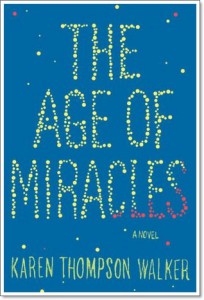In Karen Thompson Walker’s apocalyptic novel, The Age of Miracles, the Earth’s rotation has inexplicably begun to slow down. No one can explain the Slowing, which causes both days and nights to become steadily longer over the course of the novel, disrupting everything from crop growth to radiation levels. One problem spins into another unendingly, though Walker manages to avoid producing a Melvillian list of disasters. Although “no one could explain it” arises a bit too frequently as Walker’s explanation, the consequences of the Slowing appear both plausible and well-considered. The Slowing alters more than agriculture and sun-tanning, quickly leading to community disruption as religious sects break off to await end times, hippies insist on remaining in sync with the sun on “real time,” and parents hoard canned goods.
Unlike many end-of-the-world stories, Walker’s debut novel focuses on the muddle of minute shifts in everyday life rather than on cataclysmic scenes of violence and heroism. As the days begin to swell, 11-year-old Julia watches her world shifting. She regards the humiliation of not yet wearing a bra with nearly the same perplexed resignation she shows for the inexplicable slowing of the Earth’s rotation. Can Julia’s parents’ faltering marriage or the loss of her best friend be blamed on the Slowing? Or would such personal disasters have occurred even without the inspiration of a sky bereft of birds and a coast speckled with the corpses of beached whales?
As the moderate increase in gravity prevents Julia from kicking her soccer ball so blithely, the less tangible components of her life also begin to weigh on her young shoulders. The constants of Julia’s life become variables, challenging her ability to predict and evaluate her surroundings. “I had grown into a worrier,” Julia explains, “a girl on constant guard for catastrophes large and small, for the disappointments I now sensed were hidden all around us right in plain sight.” Gravity and her parents’ love alike no longer provide a predictable structure for her world, leaving Julia reeling with the instability.
Thompson adheres to realism throughout the novel, relying on recent hysterias like Y2K to guide her descriptions of society’s response to the looming apocalypse. While interesting as a thought experiment, those looking for a bit of thrill in their fiction may be underwhelmed. Walker’s prose, like her imagining, is competent, but also rather predictable.
The Age of Miracles is not so much interested in the end — the final collapse — as it is in the process of preparing for it. Written as a flashback, The Age of Miracles loses some of the exhilaration that comes from never knowing when the end might arrive, since the narrator is clearly alive enough to describe her childhood. Yet the flashback gains significance when we consider the degree to which an insecure future makes the lengthy past ever more welcoming and attractive. Walker lingers over the stockpiling and news-watching that fills up the unknown, but closely measured, remaining minutes. That these very hours and days stretch in Walker’s novel proves one of the most interesting details of her project. How is it possible to prepare and to count down to the end when the time you are rationing is itself changing?
This post may contain affiliate links.









